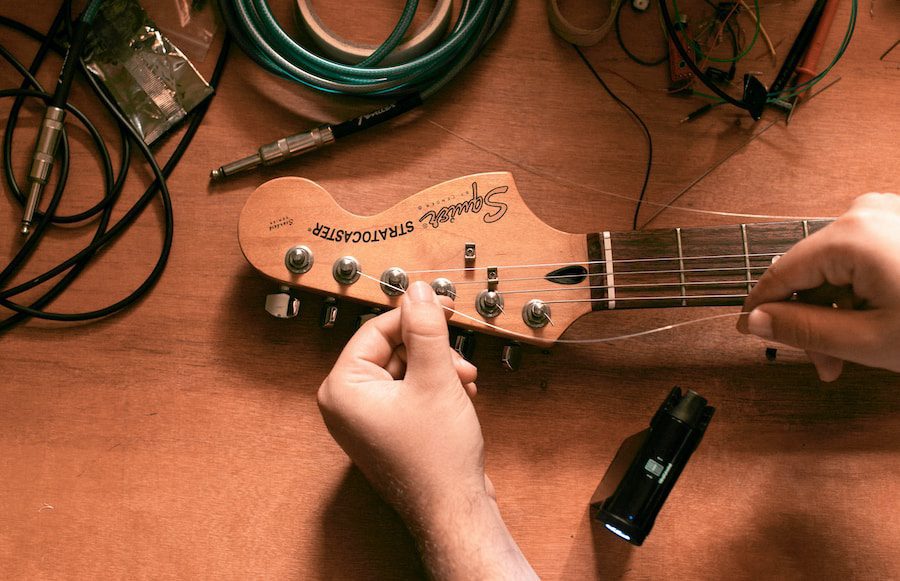Drop D tuning is a popular alternate tuning method for guitarists, especially in genres like rock and metal. It is created by lowering the pitch of the lowest (sixth) string on a guitar from its standard E note to a D note. This simple change grants musicians access to a broader tonal range while maintaining the familiarity of standard tuning for the other strings.
One of the advantages of Drop D tuning is that it allows for a heavier and deeper sound in compositions. It also makes it easier for guitarists to play power chords and alternate between them quickly due to the simplified finger positions, enhancing the overall playability. From iconic bands like Led Zeppelin to progressive modern acts, the versatility of Drop D tuning has made it a mainstay in various subgenres of music.
While the Drop D tuning can be a powerful, dynamic tool for musicians, it’s essential to understand how it affects the guitar’s overall sound and interaction with different chord shapes, scales, and techniques. For guitarists interested in exploring this tuning method, delving into its history, usage, and variations can open up a world of newfound creativity and expression.

Table of Contents
- History of Drop D Tuning
- How to Tune Your Guitar to Drop D
- Advantages of Drop D Tuning
- Popular Songs in Drop D
- Final Thoughts on Drop D Tuning
History of Drop D Tuning
Drop D tuning finds its origins in classical and modern Western music. It emerged as a popular alternative to standard tuning in the early 20th century, although some earlier composers such as Robert Johnson had experimented with it during the 1920s and 1930s.
The technique gained traction in the mid-20th century, featuring prominently on Joni Mitchell’s 1968 album “Song to a Seagull.” It continued to gain popularity in the Rock and Heavy Metal genres during the 1970s and 1980s and has since become a staple for guitarists in various genres.
Some notable artists who employed Drop D tuning throughout their careers include:
- Jimi Hendrix
- Neil Young
- Led Zeppelin
- Metallica
- Soundgarden
- Tool
Experiments with Drop D tuning have led to further innovations in guitar tunings. For instance, many musicians have explored lower tunings by dropping all six strings a whole step, resulting in the D-G-C-F-A-D tuning, also known as Drop D Flat.
How to Tune Your Guitar to Drop D
Drop D tuning is a simple yet powerful alternative guitar tuning that can give you a deeper, richer sound. In this section, we’ll walk you through the steps to tune your guitar to Drop D.
First, let’s review the standard tuning for a six-string guitar:
- E – Thickest string (lowest pitch)
- A
- D
- G
- B
- E – Thinnest string (highest pitch)
To achieve Drop D tuning, you’ll only need to adjust one string. Follow these steps to adjust your guitar’s tuning:
- Identify the low E string, which is the thickest string on your guitar.
- Using an electronic guitar tuner, tune the low E string down two half steps until it registers as D.
- Compare the low E (now D) string with the open fourth (D) string to ensure they’re in unison.
- If necessary, make minor adjustments until both the low E (now D) string and open D string are in tune with each other.
Now your guitar is in Drop D tuning, and it should sound like this:
- D – Thickest string (lowest pitch)
- A
- D
- G
- B
- E – Thinnest string (highest pitch)
It’s important to note that you may need to make minor adjustments to the other strings after tuning to Drop D, as tension changes can affect the overall tuning of your guitar.
Advantages of Drop D Tuning
Drop D tuning offers various benefits for guitarists, making it a popular choice for many styles of music, including rock, metal, and folk. Some of the advantages include:
- Easier power chords: In Drop D tuning, power chords can be played with just one finger, making it easier to perform fast chord progressions and transitions. This simplicity allows guitarists to focus more on their technique and creativity.
- Extended low range: By lowering the pitch of the lowest string by a whole step, guitarists gain access to deeper bass notes which can add depth and richness to their sound. This is particularly beneficial for heavier musical genres like metal, where a lower tuning can create a more powerful and aggressive tone.
- Alternate fingerings: Drop D tuning opens up new fingering possibilities for scales and chords, providing guitarists with fresh approaches and unique sounds. This can help inspire creativity and originality in songwriting and improvisation.
- Simplified fingerpicking patterns: For fingerstyle guitarists, Drop D can facilitate a more comfortable and intuitive fingerpicking experience. The altered tuning creates easy-to-navigate patterns that often follow a more natural hand movement.
These advantages contribute to the appeal of Drop D tuning and explain why it has become a staple technique for so many guitar players across various genres.
Popular Songs in Drop D
There are numerous popular songs that utilize Drop D tuning, spanning different genres and styles. This tuning has found favor among musicians due to the richer, heavier sound it produces. Here are some examples of well-known songs that feature Drop D tuning:
- Nirvana – “Heart-Shaped Box”
- Rage Against the Machine – “Killing in the Name”
- Foo Fighters – “Everlong”
- Soundgarden – “Spoonman”
- Alter Bridge – “Metalingus”
Drop D tuning has not only been used by rock and metal artists but also by musicians in other styles looking to experiment with their sound. For instance, even acoustic guitarists such as John Mayer have utilized Drop D in some songs, like “Neon.”
Here’s a table detailing the artist, song name, and genre of some popular songs in Drop D tuning:
| Artist | Song | Genre |
|---|---|---|
| Nirvana | Heart-Shaped Box | Grunge |
| Rage Against the Machine | Killing in the Name | Alternative Metal |
| Foo Fighters | Everlong | Alternative Rock |
| Soundgarden | Spoonman | Grunge |
| Alter Bridge | Metalingus | Hard Rock |
This sampling of songs gives a glimpse into the diverse applications of Drop D tuning, showcasing its versatility and widespread appeal among contemporary musicians.
Final Thoughts on Drop D Tuning
Drop D tuning, a popular alternate tuning for guitar, allows guitarists to expand their sonic range and can be found in various genres of music. Lowering the pitch of the 6th string to D creates new possibilities for chord shapes and riffs and provides a heavier, deeper sound.
Many guitarists find Drop D tuning to be effective for certain styles, such as rock, metal, and acoustic fingerstyle. It’s important to remember that experimenting with different tunings can unlock creativity and help musicians discover new ways of playing their instruments.
Beginners and experienced guitarists alike should give Drop D tuning a try, as it can lead to interesting musical ideas and offer a refreshing change from standard tuning. Remember to practice, explore, and enjoy the creative process.
- Review of the ALABS IRON MINI-WL: A Powerhouse Wireless Microphone - October 4, 2023
- What is a Saturator in Music Production: A Brief Explanation - May 11, 2023
- What Are Rotary DJ Mixers? An Overview - May 11, 2023
SoundStudiomagic.com is a participant in the Amazon Services LLC Associates Program, an affiliate advertising program designed to provide a means for sites to earn advertising fees by advertising and linking to Amazon.com. We also participate in other affiliate programs which compensate us for referring traffic.

